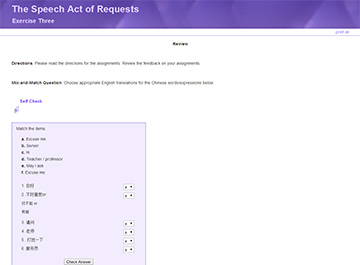Unit 3: Alerters
Unit 3 explicitly teaches students the alerters within requests in Chinese and the two main forms that are commonly used to realize the alerters in Chinese requests. This unit also provides students with exercises and activities for practice.
3.1 Goal of Unit 3
The goal of Unit 3 is to familiarize students with the alerters in Chinese requests, and to help them learn how to identify and realize alerters in request expressions.
3.2 What is an Alerter?
The alerter is an opening element that precedes the actual request, used primarily to get the hearer’s attention. It is optional to the realization of a request. In Chinese, alerters can be realized either as the form of address terms or sometimes attention-getters.
Address Terms
According to prior research findings, most of the alerters in Chinese are realized as terms of address, and different types of address terms have been used in Chinese requests (e.g., Wang, 2012; Zhao, 2006). Table 1 summarizes five commonly used address terms in Chinese requests (Wang, 2012).
| Address Terms | Examples |
| Title / Role | 老师(lǎoshī, teacher/professor), 先生(xiānsheng, Mr.), 服务员(fúwùyuán, server) |
| Surname + Title/Role | 李老师(Lǐ lǎoshī, Teacher/Professor Li) |
| First Name | 小白(Xiǎobái), 兰兰(Lánlan) |
| Full Name | 王朋(Wáng Péng), 李友(Lǐ Yǒu) |
| Kinship Terms | 爸爸(bàba, Dad), 阿姨(āyí, aunt) |
| Endearment Terms | 亲爱的 (qīn'àide, dear/darling) |
Attention-Getters
Two types of attention-getters are generally used in Chinese requests. The first is greeting expressions, such as 你好 (nǐhǎo, hello) or 您好 (nínhǎo, hello). The other attention-getters are some formulaic expressions like 对不起 (duìbuqǐ, excuse me; sorry), 不好意思 (bùhǎoyìsi, excuse me; sorry), 打扰一下 (dǎrǎo yíxià, excuse me), 劳驾 (láojià, excuse me), 请问 (qǐngwèn, may I ask), to name a few. These expressions are used not only to direct the hearer’s attention to the request, but also to show differing degrees of politeness from the speaker’s perspective.
In addition, different combinations of alerters are often used in Chinese requests. For example,
- 老师,请问……(Address term + Attention-getter)
- 你好,打扰一下……(Attention-getters)
- 对不起,请问……(Attention-getters)
Thinking: How do the alerters in American English differ from those in Chinese?
Review
Click on the Review link to access the exercise for Unit 3.
